
Going back to your days of 8th grade science, you probably remember water, good old H2O, earning the appellation “the universal solvent.” It’s a well-earned moniker. Given enough time, water can break down just about anything. That’s one reason, among others, that keeping it from accumulating is so important.
Trench drains are instrumental to ensuring the safety of our roadways, driveways, and other paved areas by diverting rainwater and other fluids. When it comes to construction styles for these drains, you have options, but many contractors opt for the classic—the cast-in-place trench drain, in which builders dig a trench, lay down a wooden frame, and fill it on site with fresh concrete. The result: a customized, purpose-built system that a precast alternative can’t offer. Let’s take a closer look at how cast-in-place trench drains manage water effectively, solving the water-management challenges that engineers face.
Gravity Always Wins
Collecting water in a trench is only the first step. Moving the water out comes next, and in the absence of a pumping system, gravity does the work of sending water away. Trench drains feature gentle slopes that are effective in transferring water downhill—it doesn’t take a 45-degree angle to get the job done. Precast trench drains come with preassigned slopes—usually between 0.5 percent and 2 percent. Because a cast-in-place trench doesn’t arrive at the worksite, builders can incorporate as much sloping as necessary to keep the water flowing to its drain channel. That could be 2.5 percent or more.
Cut-and-Cover Concrete Construction
Part of what makes a cast-in-place trench an ideal option for drainage is just how good a well-built trench can look. By covering a trench with an attractive metal grate at ground level, a cast-in-place trench is not only unobtrusive, but also a mark of conscientious engineering to residents, passersby, and other observers. Cast-in-place concrete trench drains from ABT Drains use their cement-and-aggregate construction to their advantage, boasting rustproof durability and fast flow against that universal solvent.
Adapting to One-of-a-Kind Jobs
There are many situations in which precast trenches are sufficient. However, a trench system that arrives at the jobsite ready to go isn’t an ideal solution for every plot of land or every kind of terrain. When conditions are anything other than the usual, cast-in-place trench drains manage water effectively by being adaptable to their surroundings. This makes them effective in any setting, no matter how varied the terrain. While it’s a more labor-intensive process than precast fare, it’s worth every bit of extra work when unique situations present themselves.